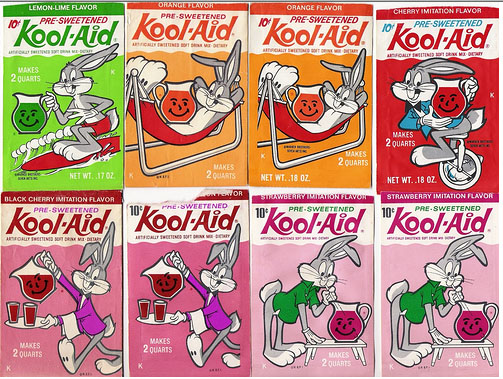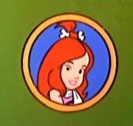
Bugs Bunny Not So Sweet. Back in 1965, Bugs Bunny was the spokesman for Kool-Aid and even appeared on pre-sweetened packages. However, those were also the days when there was a great fear about “cyclamates” (sodium cyclamate, an artificial sweetener). So when Kool-Aid removed the cyclamates, they also removed the Oscar winning rabbit (roughly around 1970, after cyclamates were banned by the US government) for fear consumers wouldn’t buy the new stuff if they saw Bugs, thinking it was the old stuff. By the way, legendary Tex Avery animated some Bugs Bunny Kool-Aid commercials but he had to convince the agency he could do the job because account executives had no idea he had ever worked on the character.
Just for fun, here’s a Kool-Aid spot by Avery, with animation by Rod Scribner and Ben Washam (thanks to Thad Komorowski for the upload).
Two Gun Rudy. Rudy Ising, part of the Harman-Ising team who produced cartoons for Warner Brothers and MGM, used to go rabbit hunting on the weekends. He strapped his guns to the side of his car on these trips and one morning when he returned to the studio, the guns brushed against the side of the wall and blew a hole in the wall, waking up any animators who had dozed off. Who taught Ising how to shoot? Bill Hanna of Hanna-Barbera.
Unknown Animators. Most fans know Bob Wood worked as an artist and editor during the Golden Age of Comic Books. He was involved with many top selling titles like the original “Daredevil” and “Crime Does Not Pay” among others. At the age of seventeen (roughly 1935), he went to New York to work on Popeye and Betty Boop cartoons for Max Fleischer. Things didn’t work out, so he went back to Boston where he tried to open his own animation shop. This venture also failed and he finally drifted into comic books. In 1958, Wood pled guilty to first degree manslaughter of a woman acquaintance and served three years in prison. A year after his release, he was murdered by some former prison acquaintances over unpaid loans.
Mighty Mouse Feature Film. In the 1980s, Robert (“Love At First Bite”/”Dr. Goldfoot and the Bikini Machine”/”Divorce American Style”) Kaufman’s Bobka Productions purchased an option from Viacom for the film rights to Mighty Mouse, which was being developed as a live action production. In 1983, at the American Film Market, Sandy Cobe of Intercontinental Releasing Corp. was promoting an animated Mighty Mouse movie. His promotion included all the merchandising tie- ins from a health food candy bar to kites.
 Now That’s Scary. “On Sunday morning, my daughter comes into my bedroom and we watch cartoons. Most of them are awfully violent. The other morning when Samantha came in, I told her, ‘Honey, you watch. I’m going to sleep a bit more’. All of a sudden, I was hearing myself, I said to her, ‘You know whose voice that is?’ She was watching ‘ThePebbles and Bamm Bamm Show’. I did the voice of Pebbles,” actress Sally Struthers told The Daily News in January 1983.
Now That’s Scary. “On Sunday morning, my daughter comes into my bedroom and we watch cartoons. Most of them are awfully violent. The other morning when Samantha came in, I told her, ‘Honey, you watch. I’m going to sleep a bit more’. All of a sudden, I was hearing myself, I said to her, ‘You know whose voice that is?’ She was watching ‘ThePebbles and Bamm Bamm Show’. I did the voice of Pebbles,” actress Sally Struthers told The Daily News in January 1983.
The First Animated Marvel Cartoons. At the 1967 Comic Convention in New York, Marvel founder Stan Lee was asked about the Grantray-Lawrence and Hanna-Barbera animated cartoons featuring Marvel superheroes. “We are having trouble with the TV shows,” grumbled Lee. “TV feels that any animated cartoon is automatically for the six year old age group and thus they insist on strict simplicity. This immediately eliminates everything that is Marvel. We just gave up on them, and since, they have gone off on their own to do all new stories. Personally, I was very dissatisfied with the way our heroes were handled.”
Smiling Lantz. Walter Lantz told the Los Angeles Times in April 13, 1982, “It’s been a wonderful life in this business, bringing laughs to so many people. I’ve never had anything to sell but humor.”
Snow White In the Park. Not THAT Park. The Daily News on February 18, 1983 revealed that theatrical producer Joseph Papp was negotiating with the Disney Company to acquire the legitimate theater rights to the animated feature “Snow White and the Seven Dwarfs”. Singer Linda Ronstadt would have played the leading role. Papp’s version would have used the original music and would have been performed free of charge in the Delacourt Theater in Central Park.
Dick Tracy Goes to Disneyland. The January 6, 1982 episode of the daily “Dick Tracy” comic strip had the famous police detective and his family visiting Disneyland. Even though the famous park wasn’t mentioned by name, the strip had a drawing of the famous Sleeping Beauty castle and Dick’s son, Joe, was talking to a Brer Bear costumed character.
It Stinks. In the 1993 divorce of actors Loni Anderson and Burt Reynolds, things got nasty including Anderson’s claim that Reynolds had not returned close to $40,000 worth of Anderson’s possessions including two Pepe Le Pew animation cels.
 Sounds Different. In Filmation’s “Star Trek: The Animated Series” (1973), a large part of the budget went to having the live action cast recreate their roles. However, the cast was scattered around the country doing other acting jobs at the time. So each actor was sent a copy of the script and told to read their dialog into a tape recorder and mail the tape back to Filmation. William “Captain Kirk” Shatner told several Star Trek convention attendees that he would record his lines in dressing rooms, hotel rooms or wherever he could find a reasonably quiet location. In the final animated series, the inconsistency of the sound quality is noticeable.
Sounds Different. In Filmation’s “Star Trek: The Animated Series” (1973), a large part of the budget went to having the live action cast recreate their roles. However, the cast was scattered around the country doing other acting jobs at the time. So each actor was sent a copy of the script and told to read their dialog into a tape recorder and mail the tape back to Filmation. William “Captain Kirk” Shatner told several Star Trek convention attendees that he would record his lines in dressing rooms, hotel rooms or wherever he could find a reasonably quiet location. In the final animated series, the inconsistency of the sound quality is noticeable.
Everyone Starts Somewhere. Stop motion filmmaker Mike Jittlov was a math major attending UCLA in 1971 but needed an art class to fulfill a graduation requirement. On a whim, he took an animation class and his world changed. His first film, made in class, was “Good Grief”, a four minute glimpse into the dreams of a child afraid of the dark.
Chuck Jones Framed. “At Warner Brothers, I did ten or twelve pictures a year which would amount to a little over an hour’s running time,” stated animation director Chuck Jones in the 1970s. “Now, you’re supposed to come in and do seventeen HOURS for a series which might have taken seventeen years at Warners. Warners taught me a great respect for a single frame of action. I feel sometimes the difference between three or four frames makes the difference as to whether people laugh or not.”
By popular demand, here’s another Avery Kool-Aid commercial:


 Jim Korkis is an internationally respected animation historian who in recent years has devoted his attention to the many worlds of Disney. He was a columnist for a variety of animation magazines. With his former writing partner, John Cawley, he authored several animation related books including The Encyclopedia of Cartoon Superstars, How to Create Animation, Cartoon Confidential and Get Animated’s Animation Art Buyer’s Guide. He taught animation classes at the Disney Institute in Florida as well as instructing classes on acting and animation history for Disney Feature Animation: Florida.
Jim Korkis is an internationally respected animation historian who in recent years has devoted his attention to the many worlds of Disney. He was a columnist for a variety of animation magazines. With his former writing partner, John Cawley, he authored several animation related books including The Encyclopedia of Cartoon Superstars, How to Create Animation, Cartoon Confidential and Get Animated’s Animation Art Buyer’s Guide. He taught animation classes at the Disney Institute in Florida as well as instructing classes on acting and animation history for Disney Feature Animation: Florida.




















































A “Star Trek” actor complaint that I heard about the Filmation series (this is a third- or fourth-hand report; I don’t know who was complaining) was that the “read your lines into the tape recorder” instruction did not provide any voice direction. So the actor had to guess from the context of the script whether a line such as “Open the door” should be in a matter-of-fact voice, a frightened voice, a humorous voice, an impatient voice, or what.
I’m sure that was pretty tricky!
barry williams (greg brady) had similar complaints concerning his voice-over work for filmation’s brady bunch cartoons.
And yet the rest of the planet can have Cyclamates all they want, go figure?
Oh, and here’s Jittlov’s cinematic opus!
http://www.dailymotion.com/video/xi9whm_good-grief_shortfilms
The Ising story explains why so many cartoon relationships are of the hunter vs. prey kind.
That first Bugs Kool Aid is night and day; day beginning at about :37.
Very pronounced difference in animation quality.
You can tell when Scribner leaves off and Washam comes in.
Tex gave Scribner the parts where he wanted the scenes to have comic distortion. He gave Washam the part where you wanted the more elegant-looking Bugs pitching the product.. Very similar to how Clampett used Scribner and McKimson in his Bugs cartoons 20 years earlier, where Bob got the scenes where you really wanted to sell Bugs’ personality animation.
Jim Korkis wrote “… so he [Bob Wood] went back to Boston where he tried to open his own animation shop …”
was bob wood from boston? i was under the impression that he was from chicago.
Who was doing Elmer’s voice in those Kool-Aid spots? Doesn’t sound like Mel Blanc.
Hal Smith.
Thanks. I knew it wasn’t Mel Blanc. I never liked his Elmer Fudd.
Hal Smith took over the voice of Elmer J. Fudd after Arthur Q.Bryan the original voice of Elmer Fudd died suddenly of a heart attack.